
Audrey Hepburn, a name that evokes images of elegance, grace, and timeless beauty, was much more than just a pretty face on the silver screen. Her life story is a testament to resilience, kindness, and the power of using one’s influence for the greater good. From her challenging early years to her rise as a Hollywood star and her later work as a humanitarian, Audrey Hepburn’s journey is nothing short of inspirational.
Early Life and War Years
Born on May 4, 1929, in Ixelles, Brussels, Audrey Kathleen Ruston (later Hepburn-Ruston) came into a world on the brink of significant change. Her father, Joseph Victor Anthony Ruston, was an English banker, while her mother, Baroness Ella van Heemstra, was a Dutch aristocrat. This mixed heritage would play a crucial role in shaping Audrey’s early life and experiences.
Audrey’s childhood was marked by constant movement and the looming shadow of World War II. Her parents divorced when she was six, an event that deeply affected her. She spent time in England, the Netherlands, and Belgium, often uprooted due to her mother’s desire to keep her safe from the growing tensions in Europe.
The war years were particularly harsh for young Audrey. Living in the Netherlands during the Nazi occupation, she experienced firsthand the brutalities of war. Food was scarce, and like many Dutch citizens, Audrey and her family often resorted to making flour from tulip bulbs to bake bread. These experiences of hunger and deprivation would later fuel her passion for humanitarian work, particularly with UNICEF.
Despite the hardships, Audrey found solace in ballet. She studied ballet throughout the war years, often performing in secret to raise money for the Dutch resistance. This early training in dance would later contribute to her graceful on-screen presence.
Rise to Stardom
After the war, Audrey moved to London to pursue a career in dance and acting. Her breakthrough came in 1951 when she was cast in the Broadway play “Gigi.” This role caught the attention of Hollywood, and soon after, she was offered the lead in “Roman Holiday” (1953) opposite Gregory Peck.
Audrey’s performance in “Roman Holiday” was nothing short of spectacular. She brought a fresh, natural charm to the role of Princess Ann, winning hearts worldwide and earning an Academy Award for Best Actress. This marked the beginning of a stellar career that would span over four decades.
Notable Films and Achievements
- “Sabrina” (1954) – Showcased her versatility as an actress
- “Funny Face” (1957) – Allowed her to display her dancing skills alongside Fred Astaire
- “Breakfast at Tiffany’s” (1961) – Arguably her most iconic role as Holly Golightly
- “My Fair Lady” (1964) – A challenging role that further cemented her status as a leading lady
- “Wait Until Dark” (1967) – Demonstrated her range with a suspenseful thriller
Throughout her career, Audrey received numerous accolades, including an Academy Award, a Golden Globe, a BAFTA, and a Tony Award. She remains one of the few people to have achieved EGOT status (winning an Emmy, Grammy, Oscar, and Tony).
Fashion Icon
Audrey Hepburn’s influence extended beyond the realm of cinema into the world of fashion. Her collaboration with designer Hubert de Givenchy created some of the most memorable looks in film and fashion history. The little black dress from “Breakfast at Tiffany’s” became an enduring symbol of elegance and simplicity.
Audrey’s style was characterized by clean lines, minimalist designs, and a certain effortless chic. She popularized:
- Cropped pants
- Ballet flats
- The boat neck (often referred to as the “Sabrina neckline”)
- Oversized sunglasses
Her influence on fashion continues to this day, with many designers and fashion enthusiasts still drawing inspiration from her timeless look.
Personal Life
Despite her glamorous on-screen persona, Audrey’s personal life was marked by both joys and challenges. She was married twice, first to actor Mel Ferrer from 1954 to 1968, with whom she had a son, Sean. Her second marriage was to Italian psychiatrist Andrea Dotti from 1969 to 1982, resulting in the birth of her second son, Luca.
Audrey often spoke about her desire for a large family, but experienced several miscarriages throughout her life. This personal struggle, combined with her own experiences during the war, fueled her later passion for helping children in need around the world.
Humanitarian Work
In the latter part of her life, Audrey dedicated herself to humanitarian causes, particularly through her work with UNICEF. Appointed as a Goodwill Ambassador in 1989, she traveled extensively to some of the poorest regions in Africa, South America, and Asia.
Her efforts included:
- Raising awareness about children affected by drought and famine in Ethiopia
- Advocating for children’s rights and education in Vietnam
- Supporting immunization and clean water programs in various developing countries
Audrey’s work with UNICEF was not just a celebrity endorsement; it was a deeply personal mission. She often said that the world’s children were “the most vulnerable members of society” and that she felt a personal responsibility to help them.
Legacy and Final Years
Audrey Hepburn passed away on January 20, 1993, at the age of 63, after a battle with appendiceal cancer. Her death was mourned worldwide, not just for the loss of a great actress, but for the loss of a truly compassionate human being.
Her legacy lives on through:
- The Audrey Hepburn Children’s Fund, established by her family to continue her humanitarian work
- Her films, which continue to captivate new generations of viewers
- Her enduring influence on fashion and style
- The inspiration she provides to those involved in humanitarian causes
In 2002, UNICEF unveiled a statue of Audrey at their New York headquarters, honoring her years of service as a Goodwill Ambassador.
Conclusion
Audrey Hepburn’s life was a remarkable journey from war-time hardship to Hollywood stardom and finally to humanitarian activism. Her grace, both on and off screen, her timeless style, and her genuine compassion for others have ensured that she remains an icon and role model long after her passing.
More than just a beautiful face or a talented actress, Audrey Hepburn embodied the idea that true beauty comes from within. Her famous quote, “For beautiful eyes, look for the good in others; for beautiful lips, speak only words of kindness; and for poise, walk with the knowledge that you are never alone,” continues to inspire people around the world.
In an industry often criticized for its superficiality, Audrey Hepburn stood out as a beacon of substance and compassion. Her life serves as a powerful reminder that one person can indeed make a difference, and that true elegance is as much about how you treat others as it is about how you look.
